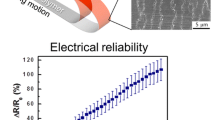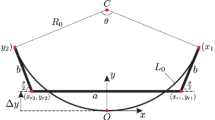Abstract
Laminated hard-soft integrated structures play a significant role in the fabrication and development of flexible electronics devices. Flexible electronics have advantageous characteristics such as soft and light-weight, can be folded, twisted, flipped inside-out, or be pasted onto other surfaces of arbitrary shapes. In this paper, an analytical model is presented to study the mechanics of laminated hard-soft structures in flexible electronics under a stickup state. Third-order polynomials are used to describe the displacement field, and the principle of virtual work is adopted to derive the governing equations and boundary conditions. The normal strain and the shear stress along the thickness direction in the bi-material region are obtained analytically, which agree well with the results from finite element analysis. The analytical model can be used to analyze stickup state laminated structures, and can serve as a valuable reference for the failure prediction and optimal design of flexible electronics in the future.


















Similar content being viewed by others
References
Yoon, J., Baca, A.J., Park, S.I., et al.: Ultrathin silicon solar microcells for semitransparent, mechanically flexible and microconcentrator module designs. Nat. Mater. 7, 907–915 (2008)
Kim, D.H.: Epidermal electronics. Science 333, 838–843 (2011). doi:10.1126/science.1206157
Kim, D.H., Lu, N., Ghaffari, R., et al.: Materials for multifunctional balloon catheters with capabilities in cardiac electrophysiological mapping and ablation therapy. Nat. Mater. 10, 316–323 (2011)
Song, J., Feng, X., Huang, Y.: Mechanics and thermal management of stretchable inorganic electronics. Natl. Sci. Rev. 3, 128–143 (2016)
Feng, X., Lu, B.W., Wu, J., et al.: Review on stretchable and flexible inorganic electronics. Acta Phys. Sin. 63, 014201 (2014). (in Chinese)
Tu, H., Xu, Y.: A silicon-on-insulator complementary-metal-oxide-semiconductor compatible flexible electronics technology. Appl. Phys. Lett. 101, 182 (2012)
Zhang, N.B., Guo, Q.Q., Yang, J.: The development of digital printing technologies for flexible electronics devices. Sci. Sin. 46, 044608 (2016)
Kim, N., Graham, S.: Development of highly flexible and ultra-low permeation rate thin-film barrier structure for organic electronics. Thin Solid Films 547, 57–62 (2013)
Ohishi, T., Kawada, H., Yoshida, T., et al.: Development of a high-performance flexible substrate for flexible electronics: joining TAC films and an ultra-thin Glassby using TEOS-DAC synthesized by the sol–gel method. Mater. Sci. Appl. 06, 1100–1110 (2015)
Song, J.: Mechanics of stretchable electronics. Curr. Opin. Solid State Mater. Sci. 19, 160–170 (2015)
Russo, A., Ahn, B.Y., Adams, J.J., et al.: Pen-on-paper flexible electronics. Adv. Mater. 23, 3426–3430 (2011)
Sun, Y., Roger, J.A.: Inorganic semiconductors for flexible electronics. Adv. Mater. 38, 1897–1916 (2007)
Lo, K.H., Christensen, R.M., Wu, E.M.: A high-order theory of plate deformation—part 1: homogeneous plates. J. Appl. Mech. 44, 663–668 (1977)
Reddy, J.N.: A simple higher-order theory for laminated composite plates. J. Appl. Mech. 51, 745–752 (1984)
Reissner, E.: On asymptotic expansions for the sixth-order linear theory problem of transverse bending of orthotropic elastic plates. Comput. Methods Appl. Mech. Eng. 85, 75–88 (1991)
Liu, D., Li, X.: An overall view of laminate theories based on displacement hypothesis. J. Compos. Mater. 30, 1539–1561 (1996)
Savithri, S., Varadan, T.K.: Large deflection analysis of laminated composite plates. Int. J. Nonlinear Mech. 28, 1–12 (1993)
Savithri, S., Varadan, T.K.: Accurate bending analysis of laminated orthotropic plates. AIAA J. 28, 1842–1844 (1971)
Sciuva, M.D.: An improved shear-deformation theory for moderately thick multilayered anisotropic shells and plates. J. Appl. Mech. 54, 589–596 (1987)
Sciuva, M.D.: Multilayered anisotropic plate models with continuous interlaminar stresses. Compos. Struct. 22, 149–167 (1992)
Sun, C., Whitney, J.M.: Theories for the dynamic response of laminated plates. AIAA J. 11, 178–183 (2012)
Carrera, E.: Historical review of Zig–Zag theories for multilayered plates and shells. Appl. Mech. Rev. 56, 287–308 (2003)
Li, X., Liu, D.: Zigzag theory for composite laminates. AIAA J. 33, 1163–1165 (1995)
Tessler, A., Sciuva, M.D., Gherlone, M.: A refined zigzag beam theory for composite and sandwich beams. J. Compos. Mater. 43, 1051–1081 (2009)
Zhu, Y.C.: Transcendence of certain trigonometric series. Acta Math. Sin. 18, 481–488 (2002)
Acknowledgements
The project was supported by the National Natural Science Foundation of China (Grants 11572022 and 11172022).
Author information
Authors and Affiliations
Corresponding authors
Rights and permissions
About this article
Cite this article
Meng, X., Wang, Z., Liu, B. et al. Third-order polynomial model for analyzing stickup state laminated structure in flexible electronics. Acta Mech. Sin. 34, 48–61 (2018). https://doi.org/10.1007/s10409-017-0670-y
Received:
Revised:
Accepted:
Published:
Issue Date:
DOI: https://doi.org/10.1007/s10409-017-0670-y




